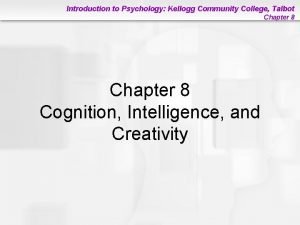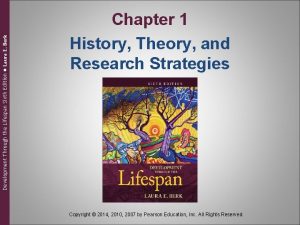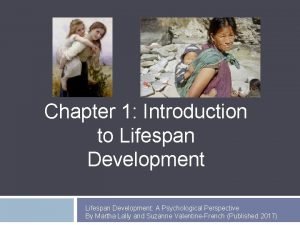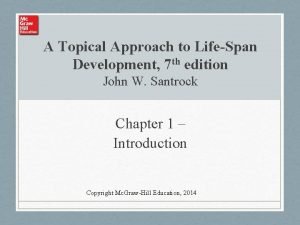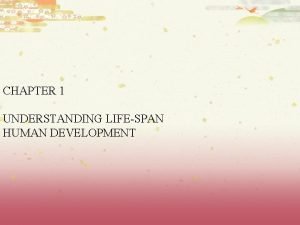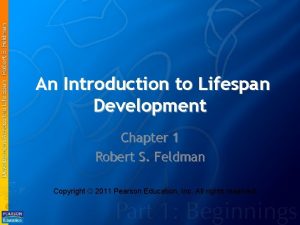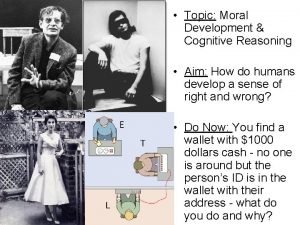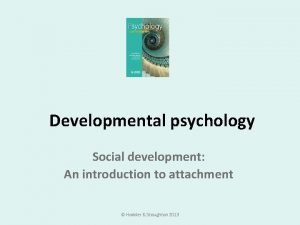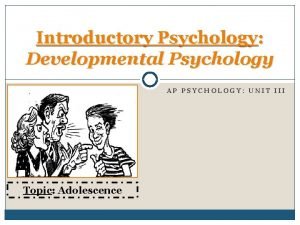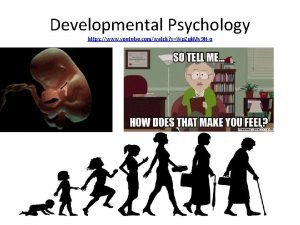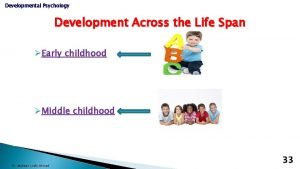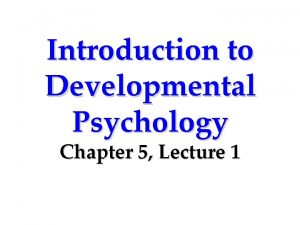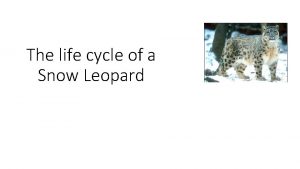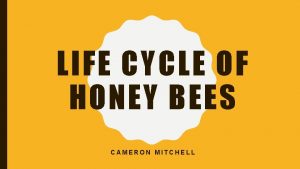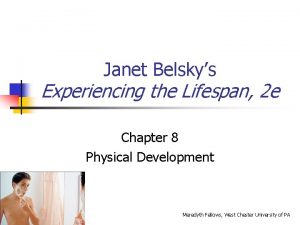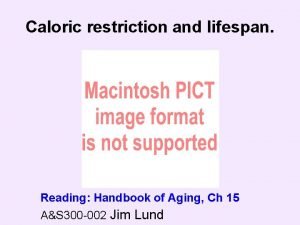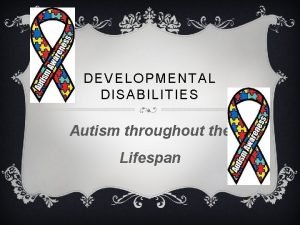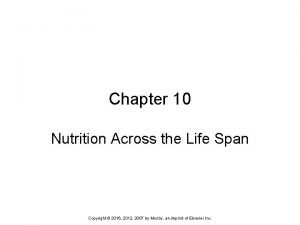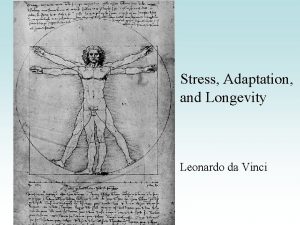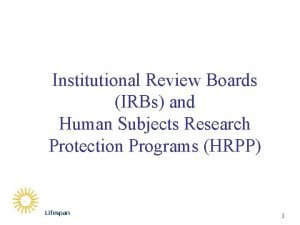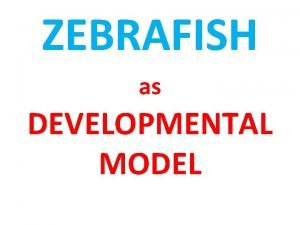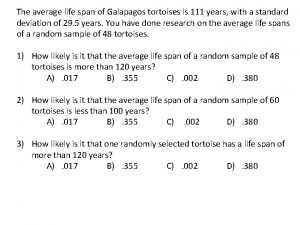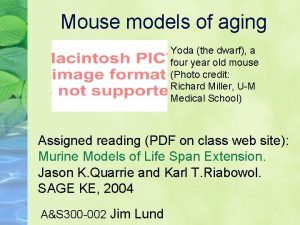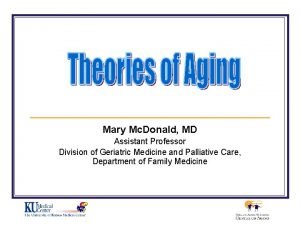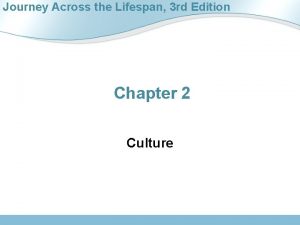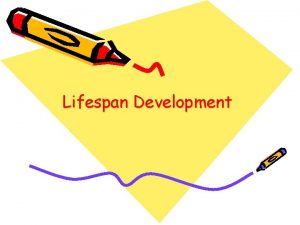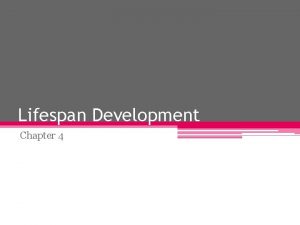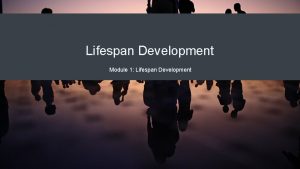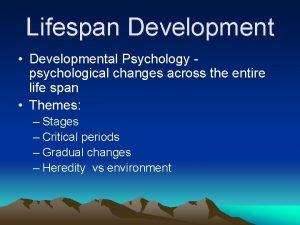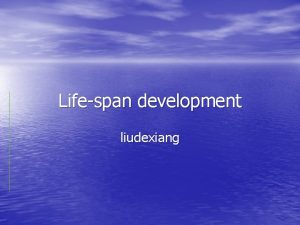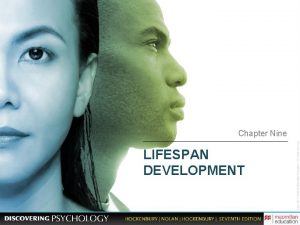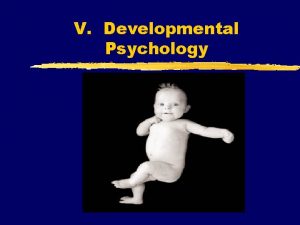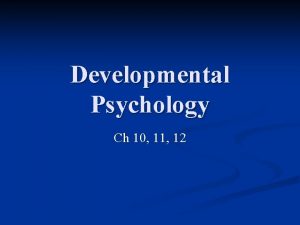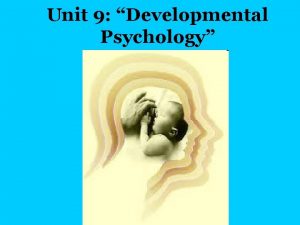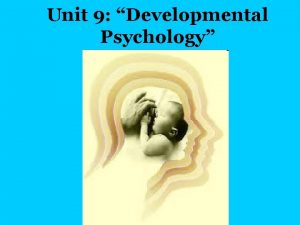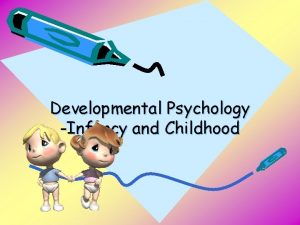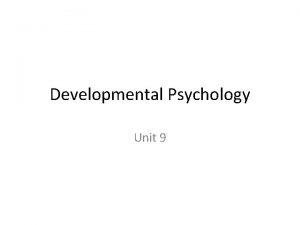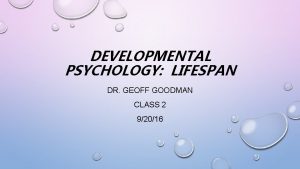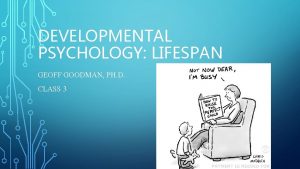Lifespan Development Developmental Psychology What shapes the way

































































- Slides: 65

Lifespan Development

Developmental Psychology • What shapes the way we change over time? • Focus on psychological changes across the entire life span • Every area of psychology can be looked at from this perspective – – biological development social development cognitive/perceptual development personality development

Fundamental Issues: Nature vs. Nurture • What is role of heredity vs. environment in determining psychological makeup? – Is IQ inherited or determined early environment? – Is there a ‘criminal’ gene? – Is sexual orientation a choice or genetically determined? • These are some of our greatest societal debates • Mistake to pose as “either/or” questions

Fundamental Issues: Is Development Continuous? • Development means change; change can be abrupt or gradual • Two views of human development – stage theories: there are distinct phases to intellectual and personality development – continuity: development is continuous

Dominant and Recessive Genes • Genotype—underlying genetic makeup • Phenotype—traits that are expressed • Dominant genes—will always be expressed if present • Recessive genes—will not be expressed unless they are in a pair

Sex Linked Traits • Traits linked to the X or Y (sex) chromosomes • Usually recessive and carried on the X chromosome • Appear more frequently in one sex than another • Color blindness, baldness, hemophilia, Fragile X

Eye Coloring Dominant brown eyes Recessive grey, green, hazel, blue eyes

Vision Dominant farsightedness normal vision Recessive normal vision nearsightedness night blindness color blindness*

Hair Dominant dark hair non-red hair curly hair full head of hair widow's peak Recessive blonde, light, red hair straight hair baldness* normal hairline

Facial Features Dominant dimples unattached earlobes freckles broad lips Recessive no dimples attached earlobes no freckles thin lips

Appendages Dominant extra digits fused digits short digits fingers lack 1 joint limb dwarfing clubbed thumb double-jointedness Recessive normal number normal digits normal joints normal proportion normal thumb normal joints

Other Dominant immunity to poison ivy normal pigmented skin normal blood clotting normal hearing and speaking normal- no PKU Recessive susceptibility to poison ivy albinism hemophilia* congenital deafness deaf mutism phenylketonuria (PKU)

Physical and Psychological Development Related • Physical development begins at conception • Physical maturity sets limits on psychological ability – visual system not fully functional at birth – language system not functional until much later • Prenatal environment can have lifetime influence on health and intellectual ability

Prenatal Development • Conception—when a sperm penetrates the ovum • Zygote—a fertilized egg • Germinal period—first two weeks after conception • Embryonic period—weeks three through eight after conception • Fetal period—two months after conception until birth

In Utero Development • 42 weeks (9 -10) months of development shown through pictures.

8 week embryo

12 week fetus

18 week fetus

20 weeks (5 months)

24 weeks (6 months)

28 weeks (7 months)

32 weeks (8 months)




Prenatal Influences on Development • • • Nutrition Anxiety Mother’s general health Maternal age Teratogens—any agent that causes a birth defect (e. g. , drugs, radiation, viruses) • Disease

thalidomide Fetal alcohol syndrome

Infant Abilities • Infants are born with immature visual system – can detect movement and large objects • Other senses function well on day 1 – will orient to sounds – turn away from unpleasant odors – prefer sweet to sour tastes • Born with a number of reflex behaviors

Infant Reflexes • Rooting—turning the head and opening the mouth in the direction of a touch on the cheek • Sucking—sucking rhythmically in response to oral stimulation • Grasping—curling the fingers around an object

Object Permanence • The understanding that objects exist independent of one’s actions or perceptions of them • Before 6 months infants act as if objects removed from sight cease to exist – Can be surprised by disappearance/reappearance of a face (peek-a-boo)

Social and Personality Development • Temperament--inborn predisposition to consistently behave and react in a certain way • Attachment-- emotional bond between infant and caregiver

Temperament • • • Chess S. , Thomas, A. (1987) Easy—adaptable, positive mood, regular habits Slow to warm up—low activity, somewhat slow to adapt, generally withdraw from new situations Difficult—intense emotions, irritable, cry frequently Average—unable to classify (1/3 of all children) Goodness of fit

Quality of Attachment • Parents who are consistently warm, responsive, and sensitive to the infant’s needs usually have infants who are securely attached • Parents who are neglectful, inconsistent, or insensitive to infant’s needs usually have infants who are insecurely attached

Harlow’s Monkeys • Social Isolation leads to serious problems • Normal development requires affectionate contact • Lack of social contact, rather than lack of parent causes the problem • Lesser periods of isolation may be overcome, longer periods cause irreparable damage • https: //www. youtube. com/ watch? v=_O 60 TYAIg. C 4

Ainsworth’s Strange Situation • Used to study quality of attachment in infants • Observe child’s reaction when mother is present with the child in a “strange” room • Observe the child’s reaction when mother leaves • Observes the child’s reaction when mother returns • https: //www. youtube. com/watch? v=QT sew. Nr. HUHU

Baumrind’s Parenting Styles • Authoritarian—value obedience and use a high degree of power assertion • Authoritative—less concerned with obedience, greater use of induction • Permissive—most tolerant, least likely to use discipline • Neglectful—completely uninvolved

Language Development • Noam Chomsky asserts that every child is born with a biological predisposition to learn language “universal grammar” • Motherese or infant directed speech-style of speech used by adults (mostly parents) in all cultures to talk to babies and children

Language Development • Infant preference for human speech over other sounds – before 6 months can hear differences used in all languages – after 6 months begin to hear only differences used in native language • Cooing—vowel sounds produced 2– 4 months • Babbling—consonant/vowel sounds between 4 to 6 months • Even deaf infants coo and babble

Language Development MONTH 2 4 10 12 24 24+ Speech Characteristic Cooing vowel sounds Babbling consonant/vowel Babbling native language sounds One-word stage Two-word stage Sentences

Young Children’s Vocabulary • Comprehension vocabulary-words that the infant or child understands • Production vocabulary--words that the infant or child understands and can speak

Piaget’s Theory of Cognitive Development • Jean Piaget (1896– 1980) Swiss psychologist who became leading theorist in 1930 s • Piaget believed that “children are active thinkers, constantly trying to construct more advanced understandings of the world” • Cognitive development is a stage process

Piaget’s Approach • Primary method was to ask children to solve problems and to question them about the reasoning behind their solutions • Discovered that children think in radically different ways than adults • Proposed that development occurs as a series of ‘stages’ differing in how the world is understood

Piaget Preoperational Stage (2– 7 years) • • Emergence of symbolic thought Egocentrism Lack of the concept of conservation Animism Concrete Operational (7– 12 years) • • • Increasingly logical thought Classification and categorization Less egocentric Conservation No abstract or hypothetical reason Formal Operational Stage (age 12 – adulthood) • • • Hypothetico-deductive reasoning Emerges gradually Continues to develop into adulthood

Critique of Piaget’s Theory • Underestimates children’s abilities • Overestimates age differences in thinking • Vagueness about the process of change • Underestimates the role of the social environment • Lack of evidence for qualitatively different stages

Information-Processing Perspective • Focuses on the mind as a system, analogous to a computer, for analyzing information from the environment • Developmental improvements reflect – – increased capacity of working memory faster speed of processing new algorithms (methods) more stored knowledge

Vygotsky’s Sociocultural Perspective • Emphasized the child’s interaction with the social world (other people) as a cause of development • Vygotsky believed language to be the foundation for social interaction and thought • Piaget believed language was a byproduct of thought

Gender Role Development • Gender—cultural, social, and psychological meanings associated with masculinity or femininity • Gender roles—various traits designated either masculine or feminine in a given culture • Gender identity—A person’s psychological sense of being male or female • Between ages 2 -3 years, children can identify themselves and other children as boys or girls. The concept of gender or sex, is, however, based more on outward characteristics such as clothing.

Gender Differences • Toddler girls tend to play more with dolls and ask for help more than boys • Toddler boys tend to play more with trucks and wagons, and to play more actively • After age 3 years we see consistent gender differences in preferred toys and activities • Children are more rigid in sex-role stereotypes than adults

Social Learning Theory Gender roles are acquired through the basic processes of learning, including reinforcement, punishment, and modeling

Gender Schema Theory • Gender-role development is influenced by the formation of schemas, or mental representations, of masculinity and femininity • Children actively develop mental categories of masculinity ad femininity and categorize these into gender categories or schemas • Trucks are for boys and dolls are for girls is an example of a gender schema

Sigmund Freud’s Psycho-Sexual Development • Most quoted of all the developmental theories • Is based on little to no scientific evidence • Found throughout culture regularly

Oral Stage (Birth to 18 months) • During the oral stage, the child if focused on oral pleasures (sucking). Too much or too little gratification can result in an Oral Fixation or Oral Personality which is evidenced by a preoccupation with oral activities. This type of personality may have a stronger tendency to smoke, drink alcohol, over eat, or bite his or her nails. Personality wise, these individuals may become overly dependent upon others, gullible, and perpetual followers. On the other hand, they may also fight these urges and develop pessimism and aggression toward others.

Anal Stage (18 months to three years) • The child’s focus of pleasure in this stage is on eliminating and retaining feces. Through society’s pressure, mainly via parents, the child has to learn to control anal stimulation. In terms of personality, after effects of an anal fixation during this stage can result in an obsession with cleanliness, perfection, and control (anal retentive). On the opposite end of the spectrum, they may become messy and disorganized (anal expulsive).

Phallic Stage (ages three to six) • The pleasure zone switches to the genitals. Freud believed that during this stage boy develop unconscious sexual desires for their mother. Because of this, he becomes rivals with his father and sees him as competition for the mother’s affection. During this time, boys also develop a fear that their father will punish them for these feelings, such as by castrating them. This group of feelings is known as Oedipus Complex ( after the Greek Mythology figure who accidentally killed his father and married his mother).

• Later it was added that girls go through a similar situation, developing unconscious sexual attraction to their father. Although Freud Strongly disagreed with this, it has been termed the Electra Complex by more recent psychoanalysts.

• According to Freud, out of fear of castration and due to the strong competition of his father, boys eventually decide to identify with him rather than fight him. By identifying with his father, the boy develops masculine characteristics and identifies himself as a male, and represses his sexual feelings toward his mother. A fixation at this stage could result in sexual deviancies (both overindulging and avoidance) and weak or confused sexual identity according to psychoanalysts.

Latency Stage (age six to puberty) • It’s during this stage that sexual urges remain repressed and children interact and play mostly with same sex peers.

Genital Stage (puberty on) • The final stage of psychosexual development begins at the start of puberty when sexual urges are once again awakened. Through the lessons learned during the previous stages, adolescents direct their sexual urges onto opposite sex peers, with the primary focus of pleasure is the genitals.

Erikson’s Theory

Kohlberg’s Theory of Moral Development • Assessed moral reasoning by posing hypothetical moral dilemmas and examining the reasoning behind people’s answers • Proposed six stages, each taking into account a broader portion of the social world

Levels of Moral Reasoning • Preconventional—moral reasoning is based on external rewards and punishments • Conventional—laws and rules are upheld simply because they are laws and rules • Postconventional—reasoning based on personal moral standards

Moral Development

Adult Development • Genetics and lifestyle combine to determine course of physical changes • Social development involves marriage and transition to parenthood • Paths of adult social development are varied and include diversity of lifestyles

Late Adulthood • Old age as a time of poor health, inactivity, and decline is a myth • Activity theory of aging—life satisfaction is highest when people maintain level of activity they had in earlier years

Death and Dying • In general, anxiety about dying tends to decrease in late adulthood • Kubler-Ross stages of dying – – – Denial Anger Bargain Depression Acceptance • Not universally demonstrated
 Barriers to problem solving in psychology
Barriers to problem solving in psychology Development through the lifespan 6th edition
Development through the lifespan 6th edition Discontinuous development psychology
Discontinuous development psychology Openstax
Openstax Exploring lifespan development chapter 1
Exploring lifespan development chapter 1 A topical approach to lifespan development
A topical approach to lifespan development Guidance counselling and lifespan development
Guidance counselling and lifespan development Lifespan development third edition
Lifespan development third edition Lifespan development third edition
Lifespan development third edition Exploring lifespan development chapter 1
Exploring lifespan development chapter 1 Sociocultural graded influences
Sociocultural graded influences Initiative vs guilt
Initiative vs guilt Lawrence kohlberg developmental psychology
Lawrence kohlberg developmental psychology Research methods in developmental psychology
Research methods in developmental psychology Wilhelm wundt structuralism
Wilhelm wundt structuralism Attachment developmental psychology
Attachment developmental psychology Adolescence ap psychology
Adolescence ap psychology Devonte is a graduate student in developmental psychology
Devonte is a graduate student in developmental psychology Authoritariam
Authoritariam Ucf psychology advising
Ucf psychology advising Sublimation psychology
Sublimation psychology Animism examples psychology
Animism examples psychology Chapter 5 developmental psychology
Chapter 5 developmental psychology Shapes that seem to follow no rules
Shapes that seem to follow no rules What do snow leopards eat
What do snow leopards eat Gulper eel life cycle
Gulper eel life cycle Petit four glace
Petit four glace Splendour beetle lifespan
Splendour beetle lifespan Life span of honey bee
Life span of honey bee Ponce de leon nationality
Ponce de leon nationality Janet belsky
Janet belsky Henry hudson 2nd voyage
Henry hudson 2nd voyage Lifespan of every animal
Lifespan of every animal The developing person through the life span 9th edition
The developing person through the life span 9th edition Characteristics of a prairie dog
Characteristics of a prairie dog Autism lifespan
Autism lifespan Nutrition across life stages
Nutrition across life stages Life span of eagle
Life span of eagle Da vinci lifespan
Da vinci lifespan Lifespan irb
Lifespan irb Henry hudson katherine hudson
Henry hudson katherine hudson Portuguese man of war habitat
Portuguese man of war habitat Lifespan of platelets
Lifespan of platelets La vecchio
La vecchio Zebrafish lifespan
Zebrafish lifespan Can sugar gliders eat beets
Can sugar gliders eat beets Galapagos turtle lifespan
Galapagos turtle lifespan Yoda lifespan
Yoda lifespan Mary wollstonecraft lifespan
Mary wollstonecraft lifespan Journey across the lifespan
Journey across the lifespan Biosphere definition biology
Biosphere definition biology Key club meaning
Key club meaning Two way anova
Two way anova Advantages of threaded binary tree over binary tree
Advantages of threaded binary tree over binary tree Perbedaan two way anova dan one way anova
Perbedaan two way anova dan one way anova One way two way anova
One way two way anova One way anova vs two way anova
One way anova vs two way anova Contoh one way anova dan two way anova
Contoh one way anova dan two way anova Conventional software
Conventional software The one was a ship
The one was a ship Talk this way
Talk this way Hình ảnh bộ gõ cơ thể búng tay
Hình ảnh bộ gõ cơ thể búng tay Frameset trong html5
Frameset trong html5 Bổ thể
Bổ thể Tỉ lệ cơ thể trẻ em
Tỉ lệ cơ thể trẻ em Chó sói
Chó sói
